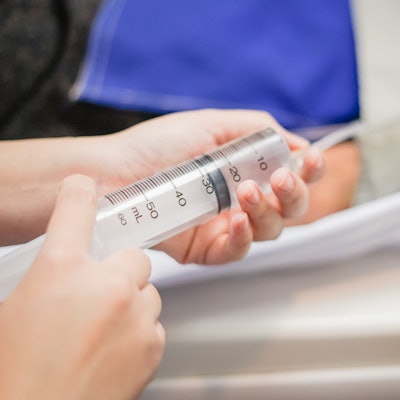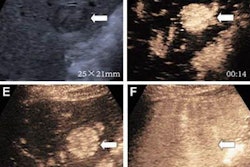
Contrast-enhanced ultrasound (CEUS) can be useful in being a secondary imaging test for ruling out small bowel ischemia in patients, according to research presented March 28 at UltraCon.
In her presentation, Corinne Wessner from Thomas Jefferson University in Philadelphia discussed her team's findings, which showed that CEUS is feasible in this area, ruling out ischemia in over 90% of cases with CT suspicion of small bowel obstruction and 60% of cases that underwent surgical intervention.
"These findings illustrate the ability of contrast ultrasound to act as a problem-solving tool for ruling out ischemia in high-risk patients," corresponding author John Eisenbrey, PhD, told AuntMinnie.com.
Quick diagnosis and early intervention are needed for suspected small bowel ischemia cases to prevent life-threatening complications. Wessner noted in her talk that the chance of mortality sharply rise from less than 10% to over 50% with a six-to-12-hour surgical delay, and to over 80% with over 24 hours of surgical delay.
However, diagnosing small intestinal ischemia and surgical strategy can be challenging even when combining contrast-enhanced CT, lab analysis, and physical exams. Previous research suggests that CEUS can effectively evaluate small bowel ischemia, with Wessner and colleagues pointing out its high temporal resolution and ability to provide rapid results. The team also wanted to show CEUS feasibility in characterizing small bowel findings using quantitative parametric mapping of CEUS blood flow parameters.
They tested this method out on 16 patients, including 14 who were deemed nonischemic and two who were ischemic. Six patients underwent surgery, none of whom showed bowel necrosis and two of whom showed bowel ischemia. The other 10 patients needed delayed surgical interventions, all of whom remained stable or had their symptoms resolve on their own.
The researchers found that quantitative parametric imaging using CEUS did not show a statistical difference between ischemic and non-ischemic bowel patients.
They also found no significant differences in area under the curve (p = 0.79), cumulative max intensity (p = 0.65), time to peak max intensity (p = 0.62), or perfusion (p = 0.57) when grouping ischemic versus non-ischemic patients.
Based on qualitative analysis by radiologists, CEUS had a sensitivity of 100% for detecting small bowel ischemia and a specificity of 85.7%.
"While we expected high sensitivity for detecting ischemia we were surprised by the high number of cases that CEUS could theoretically rule out, enabling patients to avoid unnecessary surgery," Eisenbrey said. "This reflects the performance of the ultrasound modality but also the current low specificity while working up patients for suspected small bowel ischemia."
Eisenbrey also told AuntMinnie.com that larger multi-center trials are needed and that localized exams and motion correction could improve parametric image analysis.
"We plan to investigate this technique as part of larger multi-center trials to evaluate diagnostic performance across multiple centers in a fully powered clinical study," he added.




















